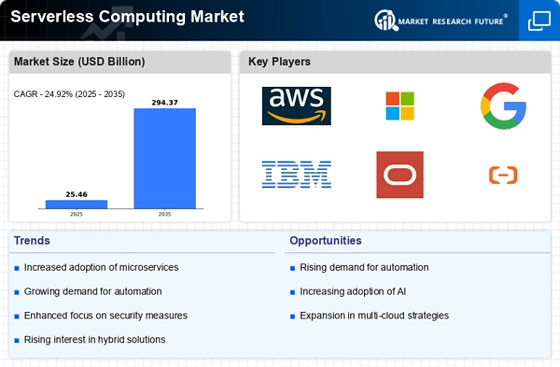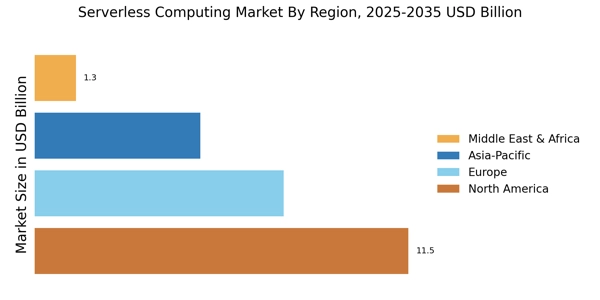Growing Demand for Scalability
The Serverless Computing Market is experiencing a notable surge in demand for scalable solutions. Organizations are increasingly seeking architectures that can automatically adjust resources based on real-time needs. This trend is driven by the necessity for businesses to handle fluctuating workloads without incurring excessive costs. According to recent data, the serverless computing segment is projected to grow at a compound annual growth rate of over 25% in the coming years. This growth indicates a shift towards more flexible computing models, allowing companies to focus on core business functions while relying on serverless platforms to manage infrastructure. As a result, the Serverless Computing Market is likely to witness a proliferation of service providers offering innovative solutions tailored to meet these scalability demands.
Enhanced Developer Productivity
In the Serverless Computing Market, enhanced developer productivity is emerging as a critical driver. By abstracting infrastructure management, serverless architectures enable developers to concentrate on writing code and deploying applications more efficiently. This shift is particularly appealing to organizations aiming to accelerate their development cycles and reduce time-to-market. Data suggests that companies adopting serverless computing can achieve up to 30% faster deployment times compared to traditional models. This increased efficiency not only fosters innovation but also allows businesses to respond swiftly to market changes. Consequently, the Serverless Computing Market is likely to attract more enterprises looking to streamline their development processes and leverage the benefits of rapid application delivery.
Integration with IoT and Edge Computing
The integration of serverless computing with Internet of Things (IoT) and edge computing is becoming a pivotal driver in the Serverless Computing Market. As IoT devices proliferate, the need for efficient data processing and real-time analytics is paramount. Serverless architectures provide a flexible framework for managing the vast amounts of data generated by these devices. This integration allows organizations to deploy applications that can respond to events in real-time, enhancing operational efficiency. Market analysis indicates that the convergence of serverless computing with IoT is likely to create new opportunities for innovation, particularly in sectors such as manufacturing and smart cities. As a result, the Serverless Computing Market is poised for growth as businesses seek to harness the potential of this technological synergy.
Rising Focus on Security and Compliance
The Serverless Computing Market is witnessing a rising focus on security and compliance as organizations become increasingly aware of the risks associated with cloud computing. As serverless architectures handle sensitive data, ensuring robust security measures is paramount. This trend is prompting service providers to enhance their security offerings, including automated compliance checks and advanced threat detection mechanisms. According to industry reports, the demand for secure serverless solutions is expected to grow significantly, with organizations prioritizing platforms that offer comprehensive security features. This heightened emphasis on security not only protects businesses from potential breaches but also fosters trust among users, thereby driving further adoption within the Serverless Computing Market.
Cost Optimization and Resource Management
Cost optimization is a fundamental driver in the Serverless Computing Market, as organizations strive to minimize operational expenses while maximizing resource utilization. Serverless computing allows businesses to pay only for the resources they consume, eliminating the need for upfront infrastructure investments. This pay-as-you-go model is particularly attractive to startups and small enterprises, enabling them to allocate resources more efficiently. Recent studies indicate that companies leveraging serverless architectures can reduce their infrastructure costs by up to 40%. This financial advantage is likely to encourage more organizations to adopt serverless solutions, thereby propelling growth within the Serverless Computing Market. As businesses continue to seek ways to optimize costs, the demand for serverless computing is expected to rise.

















